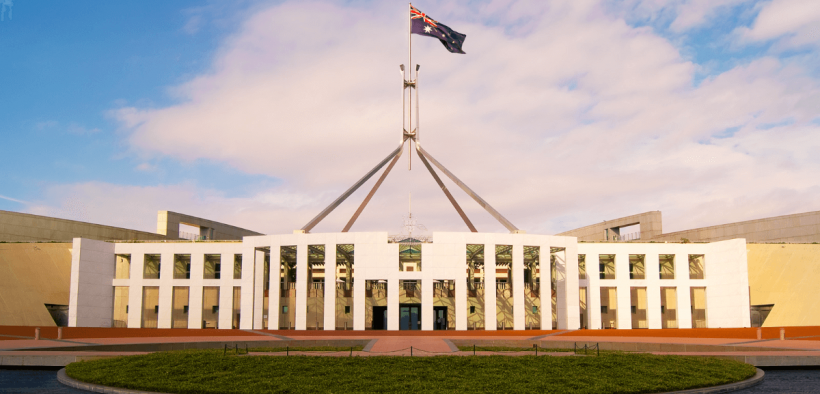Australia is now almost entirely held by Labor – but that doesn’t necessarily make life easier for leaders
Share

When Dominic Perrottet gave a gracious concession speech after his defeat in the New South Wales election on Saturday night, it was hard to avoid favourable comparison with the United States. There was no sign of rancour or hyper-partisanship. He praised Labor’s Chris Minns for a clean campaign. He predicted Minns would be a “fine” premier, urging people to “get behind him”.
But in one respect, our politics do look more American: Australia now has “red” and “blue” states, although we reverse their political colour scheme. The maps have already begun to appear on social media. The Australian mainland, with its five states and two territories, is now “red”. Only little Tasmania remains “blue”, looking like an antipodean Taiwan, with the sole surviving Liberal government in the country.
These look like good times for Labor. It is not quite there yet, but the last time – indeed, the only time – it has been in office in all nine of Australia’s jurisdictions was for a few months between late November 2007 and early September 2008, between Kevin Rudd’s federal victory and Alan Carpenter’s loss to Colin Barnett in Western Australia a little over nine months later.
The parties of the right have also only once, since 1910, held office everywhere: for just over a year, in 1969-70, between a win in Tasmania and a loss in South Australia. In those days, the bar was a little lower than today, for neither the Northern Territory nor Australian Capital Territory had gained self-government yet. Australia had six sub-national jurisdictions, not the eight of today.
An obvious question to ask of these circumstances is whether they matter for the governments involved. Is it, for example, easier for a federal government if the states and territories are ruled by the same party? Is it better for a state or territory government if the government on the federal scene has the same complexion?
Like so many historical questions, the answer isn’t simple.
If government by one party is rare in Australia, a situation where one party has become preponderant nationally is not. The 1980s, for instance, was a Labor decade in ways that extended well beyond the ascendancy of the Hawke government. Labor was also in power in New South Wales, Victoria, South Australia and Western Australia for much of the decade.
In the 1990s, there was something of a reversal. Beginning in New South Wales in 1988, all four of those states became Coalition or Liberal by 1993. To balance things a little, Labor won power in Tasmania (in an Accord with Greens Independents) and Queensland in 1989. But when the John Howard government came to office in March 1996, there was just one Labor government left in Australia, that of Bob Carr in New South Wales, which had returned to office the previous year.
These configurations very likely reverberated in federal electoral politics. In 1990, as Labor’s tide went out in Victoria, it was coming in for the party in Queensland. The early unpopularity of some hardline policies of the Kennett government in Victoria possibly helped Paul Keating in the 1993 election.
There was some irony here, since Keating’s relations with Kennett were healthy in a way they had not been with John Cain, Victorian Labor premier through much of the 1980s. Cain, who tried to steer his government on a Keynesian path in an era of economic rationalism, blamed Hawke government economic policy for many of the difficulties his state had faced during the decade.
Here is a reminder there is no guarantee of sweetness and light simply because the same party holds office in a state and in Canberra. The history of strong disagreement between federal and state governments of the same complexion is almost as long as the history of the two-party system itself.
When the Fisher Labor government sought additional powers via a constitutional referendum in 1911, it was stymied by opposition from the New South Wales Labor government, and especially the attorney-general, William Holman, who saw in the proposals a dangerous trend towards centralisation of power.
The most spectacular clashes between federal and state government have arguably occurred when they have represented different sides of politics. Those over censorship and conscription during the first world war in 1917 between T.J. Ryan, the Queensland Labor premier, and Billy Hughes, who had split the Labor Party and formed the Nationalists, were legendary.
Gough Whitlam’s exasperation with Joh Bjelke-Petersen led him to call the Queensland premier a “bible-bashing bastard”. The latter’s actions in filling a casual vacancy with a Senator hostile to the Whitlam government, and a similar action by a Liberal premier of New South Wales, damaged Whitlam. But it should be recalled that there were also strains, over money, between Whitlam’s government and that of his Labor counterpart in South Australia, Don Dunstan.
Conversely, there is little evidence until quite late in the day that the Howard Coalition government was greatly hampered by having to face a wall of Labor governments in the early 2000s.
There was a rather pointed walk-out from a Premiers’ Conference over health policy in 2003; one of the premiers involved was still chuckling about it years later when recounting the stunt to me. And the premiers, especially Victoria’s Steve Bracks, made difficulty over the Murray-Darling basin policy late in the life of Howard’s government.
Nonetheless, state and territory governments, whatever their stripe, have a strong incentive to cooperate, even if few are as simpatico as Labor prime minister Ben Chifley, and South Australian Liberal and Country League premier Tom Playford in the years following World War Two. Meanwhile, Scott Morrison’s relations with both Gladys Berejiklian and Dominic Perrottet disclose how unhappy political families can become.
Anthony Albanese will be taking nothing for granted in his relations with Labor state and territory governments. And the premiers and chief ministers will know better than to expect too many free kicks.
This article is republished from The Conversation under a Creative Commons license. Read the original article.
Frank Bongiorno AM (born Nhill, Victoria, 1969) is an Australian labour, political and cultural historian. Prior to joining the Australian National University, he held lecturing positions at King’s College London (2007-11), the University of New England (2000-07) and Griffith University (1996), and also taught previously at the ANU (1994). He has been an Australian Research Council Postdoctoral Fellow at the ANU (1997 and 1998-2000), and in 1997-8 was Smuts Visiting Fellow in Commonwealth Studies at the University of Cambridge and Mellon Visiting Fellow at the University of Texas at Austin. He has worked for the Department of Foreign Affairs and Trade.
Frank is the author or co-author of four books and many articles and book chapters on Australian history. The Sex Lives of Australians: A History (Black Inc., 2012), won the ACT (Australian Capital Territory) Book of the Year and was shortlisted in the Australian History category of the Australian Prime Minister’s Literary Award and the New South Wales Premier’s History Award. His most recent book, The Eighties: The Decade That Transformed Australia (Black Inc., 2015), was shortlisted for the Ernest Scott Prize, the New South Wales Premier’s History Award and the Council for the Humanities, Arts and Social Sciences (CHASS) Book Award, and won ACT Book of the Year.
He has served on the New South Wales Arts Advisory Council and as a member of the New South Wales Ministry of the Arts Literature and History Committee, including as its chair for three years. He is an Editorial Board member of Labour History, Journal of Australian Studies, the Australian Journal of Politics and History, and History Australia, and was co-editor of History Australia from 2013 until 2015.






Today’s Pick
11th Annual Aus Goverment Data Summit
April 1, 2025
7th Annual NZ Government Data Summit
May 7, 2025
3rd Public Sector Comms Week
May 14, 2025
Subscribe
We send emails,
but we do not spam
Join our mailing list to be on the front lines of healthcare , get exclusive content, and promos.
AI appointment Australia Australian boost boosts business businesses covid-19 cyber cyber attack cyber security cybersecurity data data breach data management defence Digital employment enhance enhances fraud funding governance government grants infrastructure Innovation Lockdown management new zealand NSW NZ online privacy public Public Sector queensland renewable energy scams security Social Media Technology telecommunications victoria
-

Understanding and building your digital strategy
Digital Government, Opinion
-

Featured Leader: Jamie Morse on multi-channel strategies for communication
Communications, Featured Leader
-

Featured Leader: Tegan Tembe of NSW Treasury on creating solid planning strategies and processes
Featured Leader
-

Wirraka Maya Health Service improves patient care with My Health Record
Learning
Show More-

Effects of ineffective communication in the workplace
Communications, Personal Development
-

7 ways you can enhance your personal development skills
News, Personal Development
-

5 advantages of working in the public sector
News, Personal Development, Professional Development
-

7 causes of communication issues in the workplace
Communications, News, Personal Development
Show MoreLast Viewed
WA Government adopts cloud-based system for grant application
Australian Gov enacts new measures to help flood-affected communities
Liberal and National Government invests $1.3B in telecommunications
Victorian Government launches $2.2M initiative to support Agtech
Featured Leader: Ken Maxwell of xAmplify on government using digital services